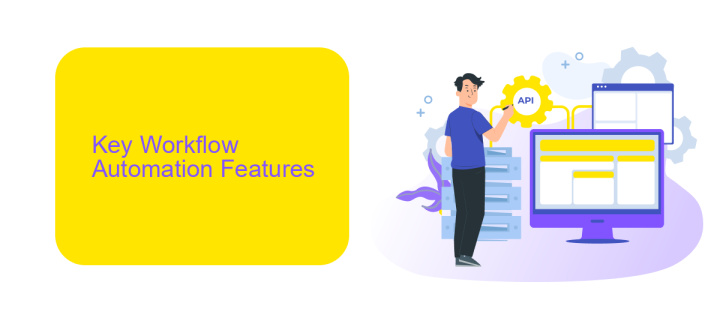Workflow Automation Features
Workflow automation features are revolutionizing the way businesses operate by streamlining processes and increasing efficiency. These tools enable organizations to automate repetitive tasks, reduce human error, and save valuable time and resources. From simple task management to complex project coordination, workflow automation is a game-changer for enhancing productivity and driving business growth in today's fast-paced environment.
Introduction
Workflow automation has become a crucial element in modern business operations, enabling organizations to streamline processes, enhance productivity, and reduce human error. By automating repetitive tasks, companies can focus on more strategic activities, thus driving growth and innovation.
- Increased efficiency and productivity
- Reduced operational costs
- Minimized human errors
- Enhanced data accuracy and consistency
- Improved employee satisfaction
One of the key components of effective workflow automation is the integration of various tools and platforms. Services like ApiX-Drive facilitate seamless integration, allowing businesses to connect different applications without the need for extensive coding. This not only simplifies the automation process but also ensures that data flows smoothly across systems, further enhancing operational efficiency.
Key Workflow Automation Features

Workflow automation is essential for enhancing productivity and ensuring seamless operations within an organization. Key features include task automation, which allows repetitive tasks to be handled automatically, freeing up valuable time for employees to focus on more strategic activities. Additionally, real-time notifications keep team members updated on task progress and deadlines, ensuring everyone stays on the same page.
Another critical feature is the integration capability with various tools and platforms. Services like ApiX-Drive facilitate this by enabling easy and efficient connections between different systems, ensuring data flows smoothly across applications. This not only reduces manual data entry but also minimizes errors, thereby improving overall efficiency. Customizable workflows and analytics further empower organizations to tailor processes to their specific needs and track performance metrics effectively.
Benefits of Workflow Automation

Workflow automation offers numerous advantages that can significantly enhance business operations. By automating repetitive tasks, organizations can save valuable time and resources, allowing employees to focus on more strategic activities.
- Increased Efficiency: Automation reduces manual intervention, speeding up processes and reducing the risk of human error.
- Cost Savings: By minimizing the need for manual labor, companies can cut down on operational costs.
- Improved Accuracy: Automated workflows ensure consistent and accurate task execution, enhancing overall quality.
- Enhanced Collaboration: Tools like ApiX-Drive facilitate seamless integration between various applications, streamlining data flow and improving team collaboration.
- Scalability: Automated systems can easily scale to accommodate growing business needs without a proportional increase in workload.
Implementing workflow automation not only optimizes everyday tasks but also provides a competitive edge by fostering innovation and agility. With services like ApiX-Drive, businesses can effortlessly integrate multiple platforms, ensuring a cohesive and efficient operational environment.
Considerations for Implementing Workflow Automation

When implementing workflow automation, it's essential to first evaluate your current processes and identify areas that could benefit from automation. Understanding the specific needs and pain points of your organization will help you choose the right tools and strategies for effective automation.
Next, consider the integration capabilities of the automation tools you plan to use. Seamless integration with existing systems is crucial for maximizing efficiency and minimizing disruptions. Tools like ApiX-Drive can facilitate these integrations by allowing you to connect various applications and automate data transfers without requiring extensive technical expertise.
- Assess compatibility with existing systems.
- Evaluate ease of use and user interface.
- Consider scalability to accommodate future growth.
- Ensure robust security features to protect sensitive data.
Finally, involve key stakeholders in the decision-making process to ensure that the chosen automation solutions align with organizational goals and receive the necessary support for successful implementation. Continuous monitoring and adjustment of automated workflows will also be necessary to adapt to evolving business needs and technological advancements.
Conclusion
In conclusion, workflow automation offers a transformative approach to managing business processes, significantly enhancing efficiency and productivity. By automating repetitive tasks, organizations can free up valuable time for employees to focus on more strategic activities. The integration of various tools and services through platforms like ApiX-Drive can further streamline operations, ensuring seamless data flow and reducing the risk of errors.
As businesses continue to evolve, the adoption of workflow automation will become increasingly essential. Leveraging the capabilities of advanced automation tools not only optimizes performance but also provides a competitive edge. By embracing these technologies, companies can drive innovation, improve customer satisfaction, and achieve long-term success in a rapidly changing market landscape.


FAQ
What is workflow automation?
How can workflow automation benefit my business?
Can I integrate different software applications with workflow automation?
Is it difficult to set up workflow automation?
What kind of tasks can be automated using workflow automation tools?
Strive to take your business to the next level, achieve your goals faster and more efficiently? Apix-Drive is your reliable assistant for these tasks. An online service and application connector will help you automate key business processes and get rid of the routine. You and your employees will free up time for important core tasks. Try Apix-Drive features for free to see the effectiveness of the online connector for yourself.

